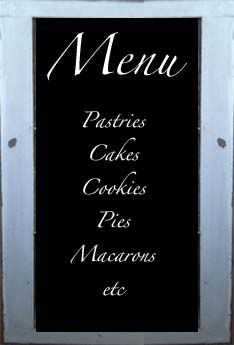The more complex answer is: it doesn't always take the traditional pie shape.
Traditionally, what constitutes a pie is fruit encased in a crust, which is so delicate that it requires the support of a tin. There is the traditional circular pie, with an upper crust and a bottom crust (i.e. apple pie), and then there is the traditional single crust pie (i.e. pumpkin).
Then there are the rustics. A rustic pie and a rustic tart are interchangeable terms to me. The biggest difference (if you wish to become a technical know it all like me) is the type of crust. A tart crust typically is more of a shortbread type of pastry. It is called pâté sucrée, or "sweet pastry," and because of the high sugar content which makes it sweet, it is sturdier and doesn't need a tin to hold it up. In fact I use a pâté sucrée aux noix (sweet nut pastry) for my Bleeding Heart cookies.
A rustic pie, also called galette, crostata, or free form pie, uses traditional pie crust (buttery, flakey and all) to make the pie. The difference is that the filling is not piled on a mile high, instead it is arranged in a fashion which is pleasing to the eye, and pleasing to the fork. Because there is no top crust you get the perfect ratio of crust to filling. You also avoid the big air gap which can occur in traditional bottom and top pies as the fruit cooks down. And also because the top is open, the steam which is released from the fruit during cooking does not get trapped by the top crust and create the dreaded SOGGY BOTTOM. You can tell I'm slightly biased towards this type of pie, but, I do love a good slice of a well made traditional pie.
Other forms of what I might constitute as pie, are really other fruit desserts: cobblers, brown betties, slab pies, crumbles, crisps and pandowdies. But let's save those for another post, shall we?
My rustic apple tart (or, if you prefer, rustic apple pie)
uses a traditional pie crust, and is folded around sliced and spiced granny smith apples. Once the crust is brushed with an egg wash and turbinado sugar graces it's frame, it is baked until the juices are bubbling and overflowing and the crust is a beautiful golden tan. Apricot jam is brushed over the grannies to enhance their appleness.
uses a traditional pie crust, and is folded around sliced and spiced granny smith apples. Once the crust is brushed with an egg wash and turbinado sugar graces it's frame, it is baked until the juices are bubbling and overflowing and the crust is a beautiful golden tan. Apricot jam is brushed over the grannies to enhance their appleness.
It has a delightfully crisp bottom and a not too sweet, as to miss out on a scoop of vanilla ice cream, filling. It serves two people. As long as apples are in season and available, I will be making these Rustic fruit desserts/breakfast/snack/enter your preferred designation.
I can always make one in a larger size, if you'd prefer. Just let me know by email, this blog, or my phone number (805) 440-3456









